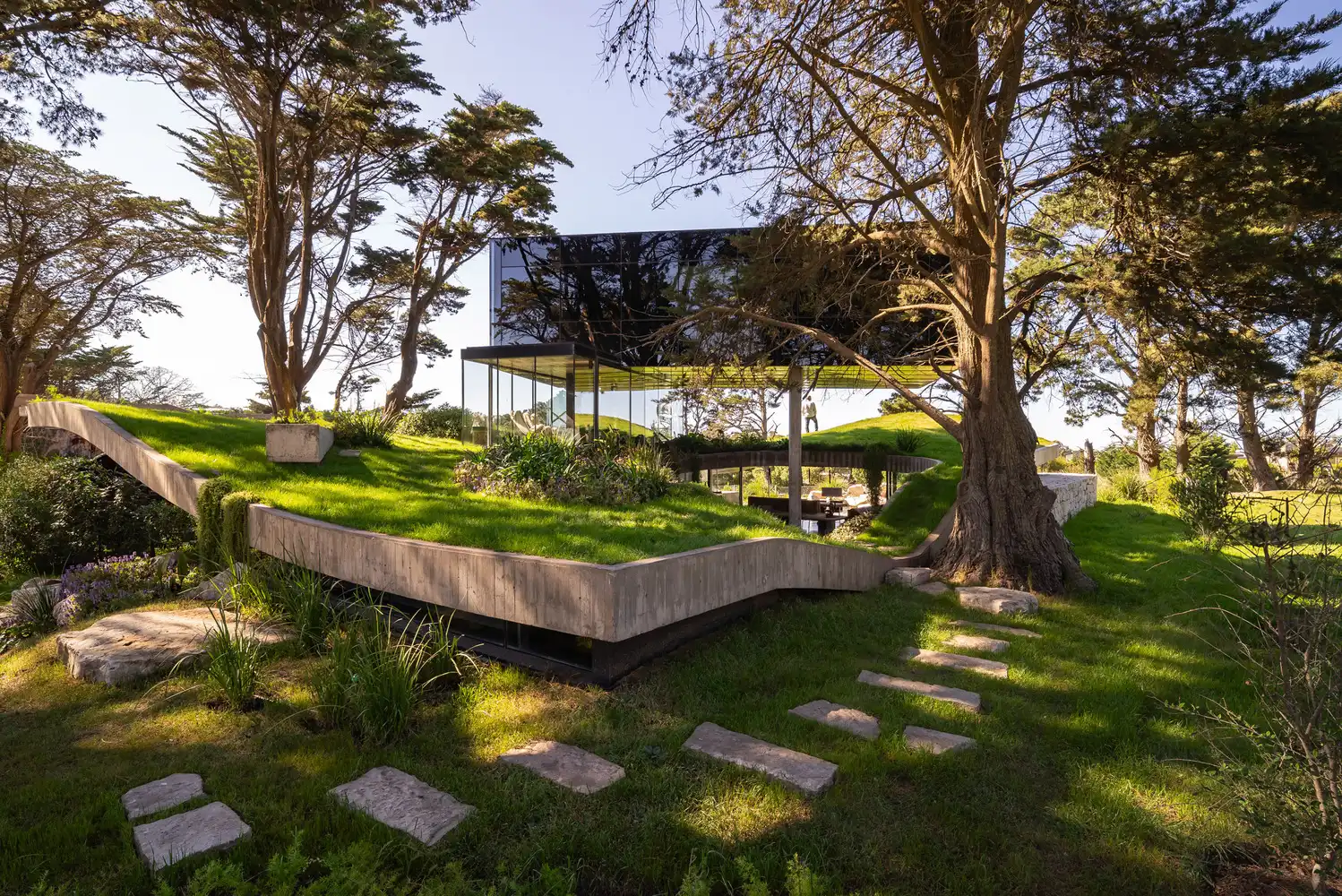House Moro is more than a home—it is a reflection of deep environmental sensitivity and architectural restraint. Designed by TAM – Guillermo Elgart, this residence is conceived with one overarching priority: respect for nature. The project responds not only to a physical location, but to an existing atmosphere, where the forest, its sounds, textures, and canopy dictate the design language.
The architecture does not seek to assert itself upon the landscape, but rather to listen, respond, and coexist. Trees were not cleared; voids were not imposed. Instead, the design celebrates the existing emptiness—the space already defined by topography, light, and vegetation.

Design Concept: Framing the Void
The project is structured around two formal gestures that subtly frame and enhance the existing site: a green mantle and a floating reflective box.
-
The Green Mantle is a wavy concrete surface that blends organically into the terrain. It functions as the roof of the primary living spaces, which are embedded below. Covered in vegetation, this mantle blurs the boundary between architecture and earth. It gently redefines the topography while preserving the spatial integrity of the forest.
-
The Reflective Box floats delicately above the green mantle. Minimal in form, the structure’s mirrored surface captures and multiplies the natural surroundings, creating an ever-shifting dialogue with the forest canopy. This box is not an object—it is a lens through which one experiences nature from a different perspective.
Together, these two elements frame the natural void of the site without interrupting it. They create a visual and experiential continuity from the street to the core of the green space, transforming the home into an architectural promenade rooted in the landscape.

Spatial Organization and Program
The spatial layout of House Moro is centered around a central courtyard, positioned beneath the green mantle and concealed from street view. This courtyard functions as the heart of the home, inviting filtered light and nature into the protected interior.
Wrapped around this courtyard is a fluid wooden core—a sinuous interior volume that serves to define and organize all functional zones. It mediates between public and private spaces and separates living areas from service zones without the use of traditional partitions. This sculptural wooden element not only introduces warmth into the concrete shell but also acts as the guiding framework of the interior experience.
Above, the floating box offers a self-contained guest suite, complete with a compact living-dining area, bedroom, bathroom, and kitchenette. Elevated within the treetops, it presents a distinct spatial experience—suspended among the branches, immersed in light and shadow.

Material Strategy and Environmental Considerations
The material palette of House Moro is restrained, natural, and intentional.
-
The concrete mantle is both structure and landscape. Its form responds to the land’s natural curves, and its green roof regenerates the surface it occupies, offering insulation and ecological continuity.
-
The floating volume is clad in a highly reflective skin, turning it into a sculptural element that disappears and reappears with changes in light and weather.
-
Inside, the wooden core provides tactile warmth and spatial fluidity, softening the geometry of the concrete shell.
In line with the architect’s environmental ethos, the house minimizes its impact through passive design strategies: cross ventilation, thermal mass, natural lighting, and the insulating properties of the earth-covered roof. The project demonstrates how architectural form can respond poetically and practically to environmental concerns.
Philosophical Framework
House Moro’s design philosophy draws inspiration from sculptor Jorge Oteiza, whose writings explore the idea of spatial voids as active, generative elements.
“The void is made, it does not exist a priori. The void is not absence but the organizing force.”
This belief is embedded in the design: volumes are not celebrated for their mass but for the space they define and liberate. The architecture actively unoccupies space—sculpting voids rather than filling them. The residence becomes a meditation on form, light, absence, and presence.

Conclusion
House Moro represents a unique synthesis of landscape, form, and philosophy. It is a home that recedes into the forest rather than competes with it. Through the subtle interplay of volumes, materials, and spatial strategies, the project offers a new model of residential architecture—one that respects, reflects, and reframes the natural world rather than imposing upon it.
TAM – Guillermo Elgart has crafted more than a structure; he has composed a living void, where every element—from the wavy concrete roof to the suspended box—exists to enhance the experience of nature. In doing so, House Moro quietly reminds us that meaningful architecture is not always about what we build—but about what we preserve.
Photography: Obra Linda & Jonathan Paz
- Architectural voids in design
- Central courtyard design
- Concrete and wood house
- Earth-covered house
- Floating guest suite design
- Forest house design
- Green roof residential design
- House Moro architecture
- Jorge Oteiza inspired architecture
- Landscape-responsive home
- Minimalist forest home
- Mirrored facade architecture
- Nature-integrated architecture
- Organic topography architecture
- Passive house in nature
- Reflective architecture
- Sculptural architecture in forest
- Sustainable house Argentina
- TAM Guillermo Elgart
- Treetop living design




































Leave a comment